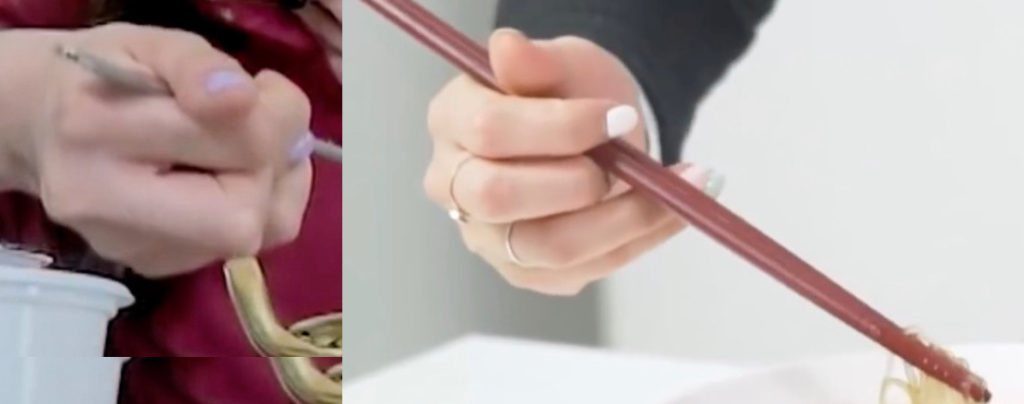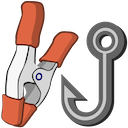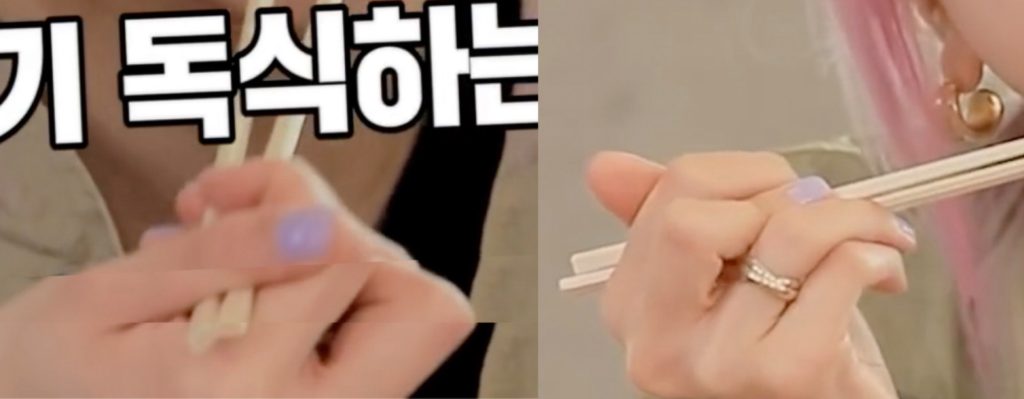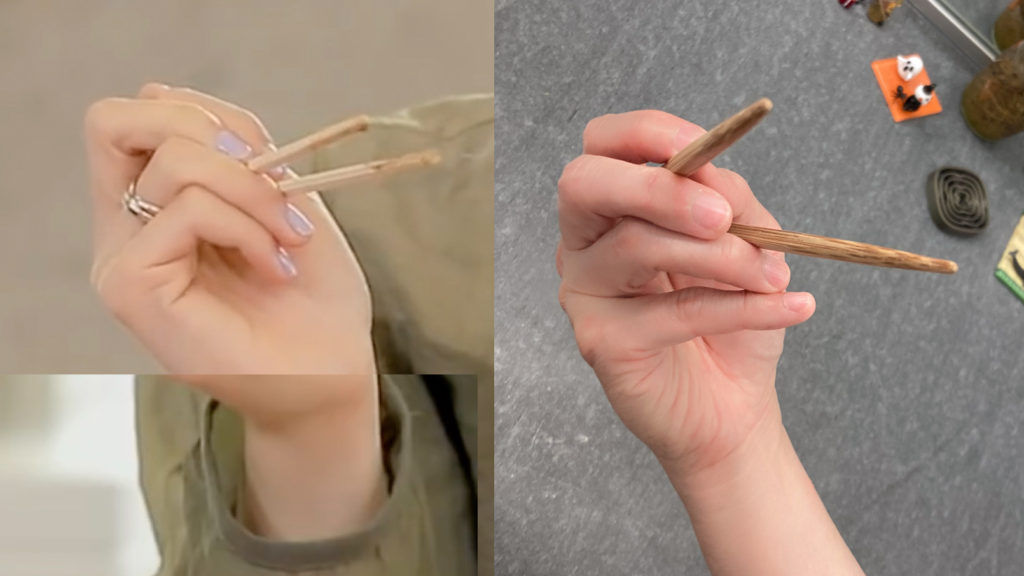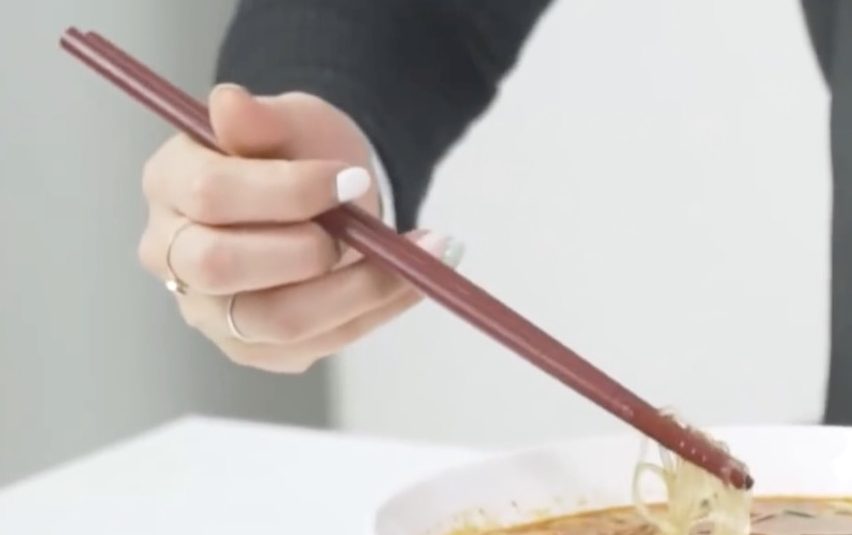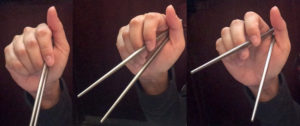Last Updated on 2021 年 08 月 25 日 by 編輯
The Hook n Clamp chopstick grip uses the index finger to pry chopsticks open, and the middle finger to clamp chopsticks shut. This grip is most closely-related to Chicken Claws, Double Hook, and Idling Thumb. But it also shares similarities with Dino Claws for the hook, with Scissorhand for clamp, and with Lateral grips for the way it clutches two chopsticks shut.
Key postures of this grip are shown below. From left to right, they are: 1) Open posture, 2) Closed posture, 3) Compression posture, and 4) Abutting posture.

Pictures of Chaeyoung are taken from various episodes of “TIME TO TWICE” such as Yes-or-No episode 2, episode 3, TDOONG Forest episode 2, episode 3 and episode 6. Our in-depth article Chopstick Grips of TWICE Members describes chopstick grips of all 9 TWICE members.
內容目錄
The name
This grip is named after the way the index finger and the middle finger move the top chopstick. The index finger curls and hooks onto the top chopstick, shown below left. This allows the index finger to lift up the top chopstick, extending chopstick tips apart. When it comes time to pinch food, the middle finger clamps down on the top chopstick, pinning it against the bottom chopstick, shown below right.
The following sequence illustrates how tips of chopsticks are extended apart. In this grip, both chopsticks move. The ring finger and the pinky move away from other fingers, extending the bottom chopstick away from the top chopstick. This creates a gap between the two sticks, allowing the index finger to hook onto the top chopstick, and pry it away further from the bottom chopstick. Once the two chopsticks are separated far enough, the ring finger and the pinky curl inward back to their regular position.

Closing tips of chopsticks around a food item is more straightforward. The index finger flattens and abuts the top chopstick as if it were a clamp. Using the full weight and strength of the index finger, the practitioner clutches the two chopsticks shut.

Compared to Chicken Claws
Hook n Clamp is closely related to Chicken Claws. These two grips share the same bottom chopstick placement. The bottom chopstick rests on the knuckle of the ring finger. As mentioned in the Chicken Claws article, this placement is inherited from Idling Thumb which preserves such bottom chopstick placement from Standard Grip.
These two grips also share similar, but not identical handling of the top chopstick. Neither of these grips use the tip segment of the thumb, unlike Standard Grip. This is a trait introduced in Idling Thumb, and exaggerated in Chicken Claws and Hook n Clamp. These two grips use “lift” up the top chopstick. In the case of Hook n Claws, shown above left, only the index finger is used to hook onto the top chopstick. The index finger alone lifts the top chopstick. In the case of Chicken Claws, shown above right, the index finger and the middle finger sandwich the top chopstick for better purchase. Together these two fingers lift the top chopstick.
Both grips share the physical mechanism for clutching chopsticks shut. This mechanism is similar to that employed by all Lateral grips, even though these two grips are technically not Lateral grips. Lateral grips rest the bottom chopstick on the middle finger knuckle. These two grips rest the bottom chopstick on the ring finger knuckle as mentioned earlier. Nonetheless, the shared mechanism has Hook n Clamp compress both chopsticks using the middle finger, the palm, the base of the thumb, and the purlicue, such that the two chopsticks abut each other.

The two grips differ in the finger they use to compress chopsticks. Hook n Clamp, shown above left, employs the middle finger to compress chopsticks. Chicken Claws on the other hand, shown above right, employs the index finger.
A variant: Double Hook
In May 2021, we noted that Jane from the YouTube episode on chopsticking from WorldFriends used a variant in between Idling Thumb and Chicken Claws. We couldn’t quite pin down, at that time, Jane’s grip in the family tree of chopstick grips. We also did not know how to name it.
Jane extends chopsticks apart with Idling Thumb, but closes them against food items with Lateral compression. This hybrid approach is also seen in the Lateral Turncoat grip, where Turncoat extension is used in combination with Lateral compression. It is also similar to how Chicken Claws adopts a Lateral compression, and an Idling Thumb-like extension. Following images show the Closed posture (left) and the Open posture (right) from one part of the video.
Once we analyzed Chaeyoung’s grips, we then had a name for both of these. We named Chaeyoung’s grip, the Hook n Clamp grip, because her index finger acts like a hook, and her middle finger works like a clamp. For Jane, both her index finger and her middle finger are used like a hook. So we named Jane’s grip the Double Hook grip.
Following pictures compare and contrast Chaeyoung’s Hook n Clamp, on the left, to Jane’s Double Hook, on the right. They illustrate how these two practitioners lift up the top chopstick.
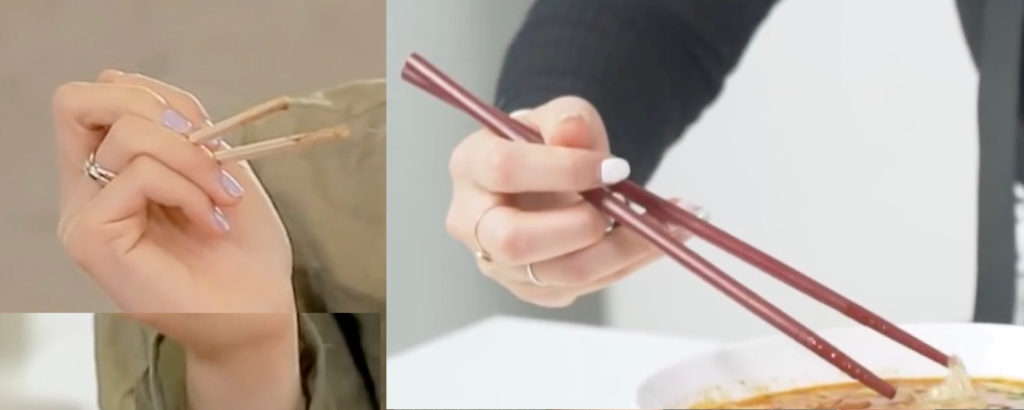
Following pictures show both of them clutching chopsticks shut.
